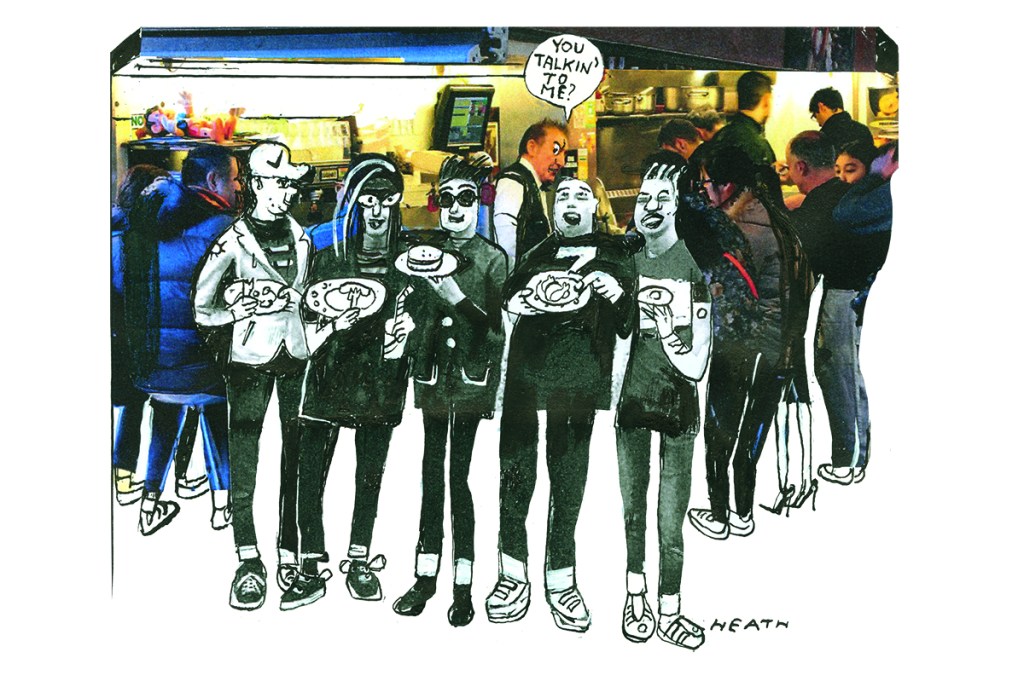This article is in The Spectator’s January 2020 US edition. Subscribe here.
Going into Spoken English, you feel a little like Henry Hill taking the back entrance to the Copa in Goodfellas. Wander into the Line Hotel, past the check-in, take a right past the elevators and enter the kitchen. It works best if you’re with someone you need to impress. Unfortunately, this time I’m with a Spectator editor.
The Line is one of DC’s newest and hippest boutique hotels. That’s another way of saying it’s slightly less boring than the Hilton about five blocks away. Still, it’s a welcome addition to a neighborhood that’s mostly known for Dan’s Café, a bar that serves your liquor of choice in a giant ketchup squeeze-bottle that you can drink all night. Not to impugn that brilliant innovation, but they haven’t followed through on the concept. If they’re putting you on liquids all night with a squeezy bottle, they should offer you a diaper and a nap too.
Spoken English is memorable for its food but more so for its seating — or the lack of it; it is the only standing-only restaurant in town. You take your Asian repast on your toes, hovering around a few communal tables overlooking the kitchen.
We walked into Spoken English on a Tuesday night without a reservation. The owner, Erik Bruner-Yang, is a stand-up guy and no stranger to gastroconceptual experiences. He’s already subjected the patient diners of DC to Maketto, part-coffee shop, part-streetwear marketplace and part-Cambodian restaurant.
Before that he started one of DC’s first ramen bars, Toki Underground, and outfitted it with skateboard decks and Japanese toys and music blaring at industrial volume. I’ve yet to hear about a dish in DC that can compare with the fatty, oily, heavenly bowls of noodles Erik served at Toki — and not just because of the tinnitus.
The standing restaurant is new to America, but tachinomiya (stand-up bars) are big in Japan. A stand-up dinner is the signature shtik of Ikinari Steak, which has more than 300 locations in the land of the standing diner. Ikinari’s aim is to get you in and out within 30 minutes. The Japanese must have more important things to do than nuzzling a ribeye; Americans, less so.
Ikinari arrived here in 2017 by opening 11 restaurants in New York City. Earlier this year, it closed all but two of them.
It’s not just the Japanese who eat while standing. Less efficient nations do it too. Walk down any street in Paris and you’ll see people strolling out of a boulangerie and elegantly stuffing a croissant or sandwich into their faces as they stroll down the boulevard to take a standing café at a zinc. European cafés have a special tariff if you’re going chairless; the Italians call it al banco — at the counter.
Americans, too, stroll around with cardboard cups of tea and coffee — not forgetting the ubiquitous water bottle that we carry at all times, for we dehydrate faster than any other people. We also do after-work tachinomiya by standing around in bars in large groups. Even desk workers stand up. Mixed in between ads for Cialis, gold sovereigns from wrecks off the Florida coast and reverse mortgages, every daytime news channel in America carries ads trying to sell you a standing desk. Walk into any office building today and you’ll see a fleet, each with its crew member standing at the controls like he’s piloting the Starship Enterprise. Studies confirm the health benefits of standing all day, especially without a drink in one hand and a cigarette in the other.
Americans love to stand while eating — at least, sometimes. The corn dog is up there with ranch dressing and the slider as one of America’s gastro- gifts to the world. I’m sad to report that the effete Brits on the Spectator staff quail at the thought of eating a corn dog; one of them even thought it was a prairie-dwelling animal. But walking and eating are central to that most American of activities, the state fair: deep-fried pork chop on a stick, deep-fried pizza or even, yes, deep-fried butter. Is there something sacred about steak that means we have to sit down to eat it?
Spoken English has the same flair as Bruner-Yang’s other DC ventures. But will the trough-dining denizens of DC stand for it? The gaggle of young women standing next to our non-table were eagerly swiping left and right on Tinder between bites, laughing and barely registering the fact that they weren’t seated. They might have been more animated because they were standing.
Perhaps we’ve stumbled on to something. Just be careful while you stumble: the kitchen is right there. You’ll pass it on your way to the one place where, thank God, Bruner-Yang allows you to sit.
This article is in The Spectator’s January 2020 US edition. Subscribe here.


























